Siamese cats are fascinating creatures, with many mysteries still waiting to be uncovered. One question that often comes up among Siamese cat owners is whether these cats have periods. The answer to this question isn’t as straightforward as you might think.
Cats do not experience a monthly bleeding cycle. Instead, the changes that occur in them are related to their estrus cycle or heat cycle.
Cats enter a period of increased activity. This is when they start roaming around and marking their territory vigorously. They may also become more vocal, and their tail may wag more.
I’ll discuss what periods are like for Siamese cats in this article. I’ll likewise provide tips for making her as comfortable as possible. Keep reading to learn more!
Do Siamese Cats Have Periods?
Female cats have a reproductive cycle but do not experience
menstruation in the same way that human females do. Instead, they experience “estrus” or “heat.”
The estrus cycle occurs when the cat is ready to mate and is necessary for reproduction. You must be aware of your female Siamese cat’s estrus cycle and watch for signs that she is in heat.
The estrus cycle in cats lasts about two weeks and usually occurs twice a year. The female cat’s body will go through some changes during this time. She may become more affectionate, vocal, and restless. The female cat will usually go into a period of rest and recovery after the heat cycle.
What are the Signs of Estrus in Cats?

Estrus is the period in a female cat’s reproductive cycle when she is receptive to mating. The cat’s behavior will change during estrus, and she will be more attracted to male cats.
There are several behavioral signs which indicate a cat is in estrus. Not all cats show these signs, and some may exhibit different behaviors altogether:
Male cats will be drawn to your female cat like magnets, so keep them separated if possible. You may also want to keep her inside so she doesn’t get pregnant.
Do Cats in Heat Bleed?
Cats do not generally bleed when in heat, but they can do so. Some cats will bleed a small amount during estrus, but this is not common.
There are a few possible causes of bleeding during a heat cycle. One possibility is that the cat may have a vaginal infection. This causes the tissues to become inflamed and irritated, which results in bleeding.
Another possibility is that the cat may have a uterine infection. Urinary tract infections are common in cats. These can cause other symptoms like straining to urinate or frequent trips to the litter box. A urinary tract infection can be painful and dangerous for cats. Thus, prompt treatment is crucial.
What you can do to help:
- Make sure your cat does not lick or bite at the area where it is bleeding. This can lead to further injury and can make the bleeding worse.
- Take your cat to the veterinarian for an examination. The vet will determine what is causing the bleeding and provide appropriate treatment.
What to Do if Your Cat is in Heat for the First Time?

- One option is to introduce them to catnip. Catnip is part of the mint family and is known to have a calming effect on cats. You can find it in pet stores or online.
Some cats may become more active after exposure to catnip. Others may become more at ease. Start with a small amount of catnip and see how they respond to it.
- Cats in heat can be agitated, but you can help calm them by playing with them. Cats in heat often become agitated because they are looking for a mate. You can help take their mind off of their search by playing with them to help them relax.
Try to stick to short games. Avoid anything that might excite the cat too much, such as running around or batting at a toy mouse.
Also, take frequent breaks. You don’t want to over-exert the cat, especially if she’s already agitated.
You can try giving her a gentle massage if your cat is still agitated after playing. This will help release any tension she may be feeling.
- A heating pad may be the thing you need. Place the heating pad in her favorite spot and let her lie down. You may also want to consider using a pheromone diffuser to reduce stress and anxiety in cats.
- Keep your cat indoors. This will help reduce her stress levels and make it easier for you to check on her. Provide her with plenty of toys, scratching posts, and hiding places to keep her occupied. Give her extra attention and affection to help her feel comfortable and secure.
Can You Spay a Cat in Heat?
You should wait at least one month after your cat’s heat cycle before scheduling surgery, according to vets.
Cats spayed during their heat cycle may experience bleeding and be
at risk for complications during surgery. Be sure to talk to your vet about the risks involved and what can be done to minimize them.
Spaying your cat helps reduce the number of homeless cats and kittens. Spaying your cat before they reach sexual maturity helps prevent unwanted pregnancies and decrease the number of cats in shelters.
Conclusion
Siamese cats do not experience a traditional period as humans do. Instead, they go into heat for a few days to a week, during which they will mate with male cats.
Keep track of when your Siamese cat will likely be in heat. Also, keep them from other cats during this time if you do not want your Siamese cat to mate.
Be sure to check back soon for more posts on interesting Siamese cat facts. Thanks for reading!
We gathered all the health tips tailored toward maintaining your Siamese cat’s optimal well-being. Check it out here: Siamese Cat Health: A Complete Guide

